Wholesome, hearty, and packed with flavor, this Masoor Dal is a must-have in your weekly rotation. It’s made with pantry staples, comes together easily, and is naturally vegan and protein-rich. This simple step-by-step recipe makes this authentic masoor dal easy for a weeknight dinner or meal prep.
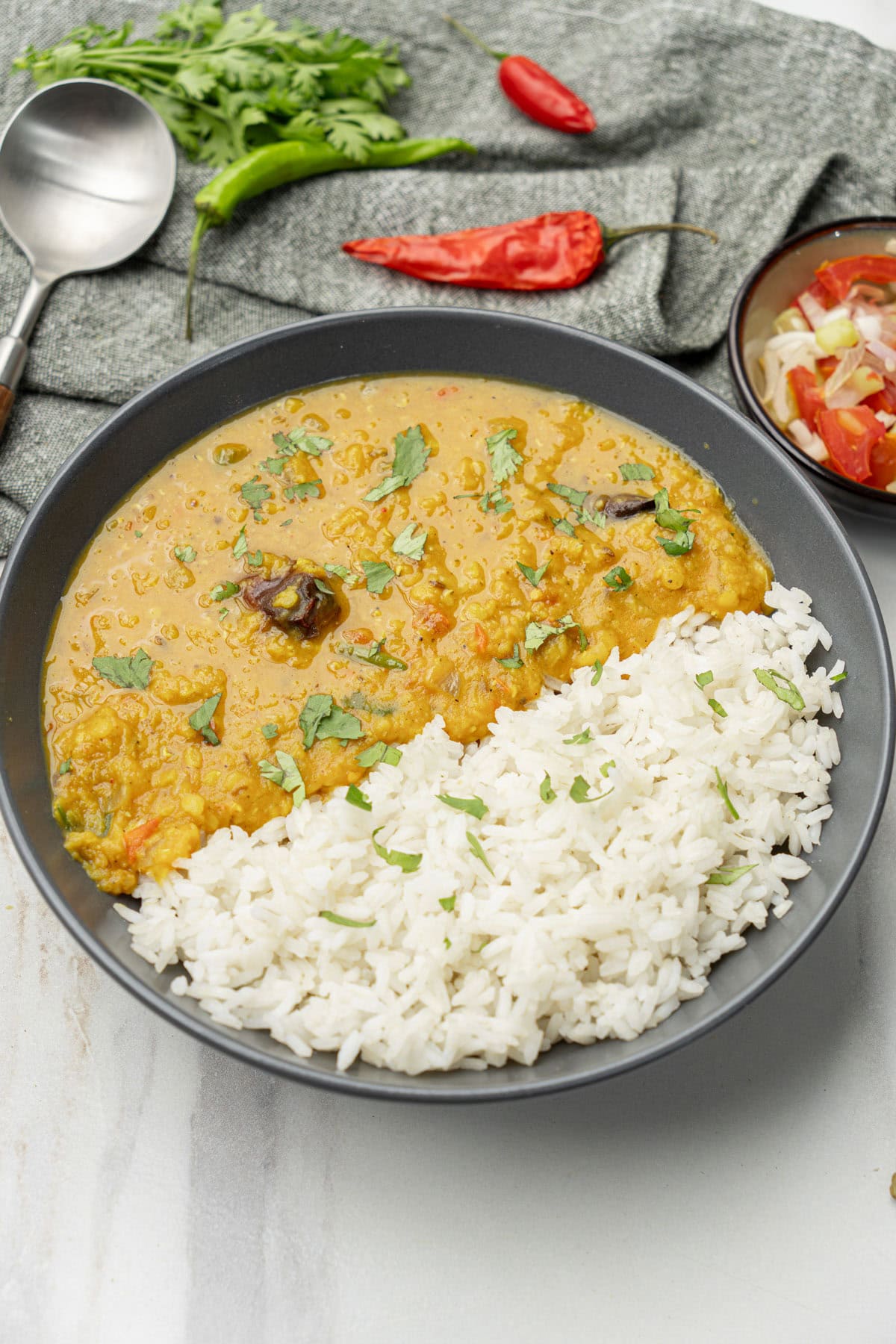
An Indian meal is never complete without dal, and when it comes to simplicity and comfort, Masoor Dal is my go-to, similar to Moong Dal and Toor Dal Tadka!
This is one of my favorite recipes—it’s quick, full of flavor, and super satisfying. Soft red lentils are cooked with tomatoes, garlic, and simple spices to make a dish that’s both nutritious and delicious.
Masoor Dal, also known as red lentil dal, is commonly made in Indian homes. It’s high in protein, easy to make, and great for everyday meals. You don’t need a lot of ingredients, and it tastes incredible. Serve it with basmati rice or roti for a complete and filling meal.
Every family has its own way of making masoor dal—some like it spicy, while others keep it mild. Usually, we make this dal with split red lentils, but you can also use whole red lentils in this recipe. They will just take a little longer to cook.
Here, I first boil the dal separately in the pressure cooker or in a pot on the stovetop. Then we prepare a tadka (tempering) in a pan and add the cooked dal to it. If you want to make this dal as a one-pot recipe where the dal is cooked with the tempering, then check out my Instant Pot red lentils recipe.
Table of Contents
What is Masoor Dal?

Masoor dal, also known as red lentils, is a type of lentil commonly used in Indian cooking. It comes from the plant Lens culinaris.
The whole masoor dal has a brown outer skin, but when hulled and split, it becomes the red lentils we commonly use in cooking. It are also called dhuli masoor dal or lal masoor in Hindi.
These red lentils cook quickly and have a mild, slightly sweet flavor, making them perfect for soups, stews, and dal.
Ingredients
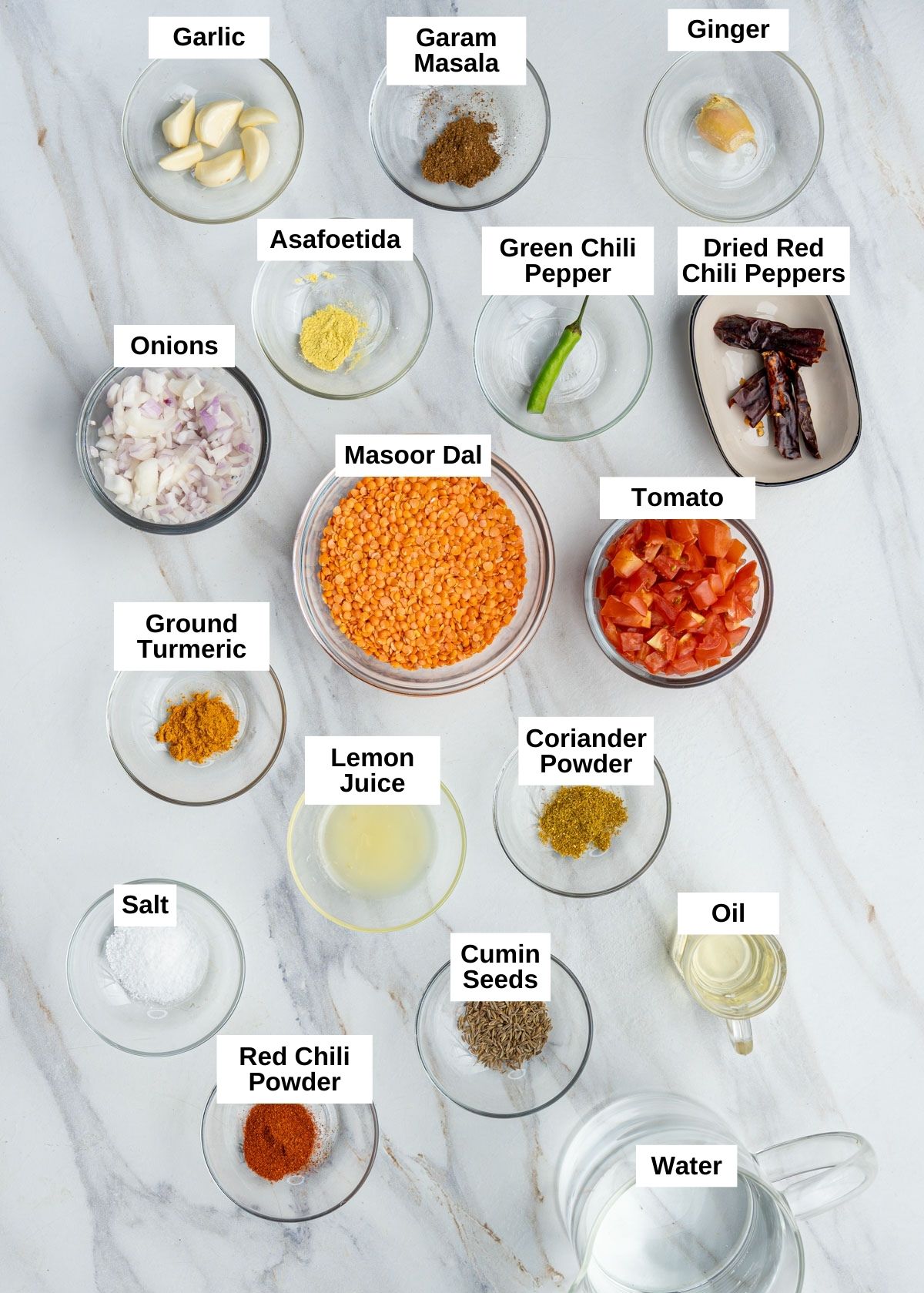
- Masoor Dal (Red Split Lentils): These are one of the most common types of lentils and can be found in most regular grocery stores in the U.S.
- Spices: This dal uses basic Indian spices like coriander, cumin, red chili powder, asafoetida (hing), salt, and turmeric. Garam masala is optional, but I like to add a little at the end—you can skip it if you don’t have it.
- Garlic and Ginger: Fresh is best, but you can also use ginger and garlic paste.
- Dried Red Chili Peppers: These add a nice smoky heat to the dal. You can adjust the quantity based on how spicy you like your food. If you don’t have them, you can skip.
- Yellow Onion: This adds a sweet and savory base flavor to the dal. For maximum flavor, it’s best to cook the onion until it turns golden brown.
- Green Chili Pepper: Adds a fresh, spicy kick.
- Tomato: Adds tanginess and a slight sweetness. Fresh tomatoes work great.
- Lemon Juice: Adds a fresh tang. It balances the flavors really well.
- Cilantro Leaves: For garnishing at the end.

Pro-Tips
Ghee or Oil: I love using ghee when making dal—it gives a rich, authentic flavor that feels so comforting. But if you’re vegan or dairy-free, just use any neutral oil you like.
Dal Choices: This recipe uses masoor dal (red split lentils) because they cook quickly and have a soft, creamy texture. But you can also use a mix of lentils for more depth—try combining red lentils with split moong dal (yellow or green) or toor dal.
Rinsing the Dal: Don’t skip this step! Washing the lentils a few times helps remove excess starch and any dust from the packaging.
Gluten-Free Option: If you’re gluten-free, skip the hing (asafoetida) unless you have a certified gluten-free version. Traditional hing often contains wheat flour, so just double-check the label or leave it out altogether.
Make It Ahead: Dal tastes even better the next day as the flavors deepen. It also freezes well—just cool it completely, store in small portions in airtight containers, and freeze for up to 2 months. Make sure to thaw it overnight and reheat well before serving. You may need to add a splash of water to brighten up the dal as it does thicken as it is stored.
How to Serve Masoor Dal?
For a simple, comforting meal, serve masoor dal with steamed rice, jeera rice, or chapati/roti. You can also pair it with paratha.
Add a simple veggie stir-fry such as aloo gobi, aloo beans, or bhindi masala and a fresh cucumber raita on the side for a complete meal.
Add a mango pickle or kachumber salad alongside a crunchy papad. Drizzle some ghee tadka on top for added flavor. You can even enjoy it as a light lentil soup with crusty bread.

Frequently Asked Questions
No, masoor dal doesn’t need to be soaked as it cooks quickly. However, it is important to rinse it well before cooking to remove dust or impurities.
Simply use a plant-based oil instead of ghee.
Leftover dal can be stored in an airtight container in the fridge for up to 3-4 days. It also freezes well for up to a month. Just thaw and reheat with a splash of water.
Lentils & Beans
Dal Fry
Vegetarian
Horsegram Dal (Kulthi Dal)
Lentils & Beans
Dal Makhani
Lentils & Beans
Red Chori Curry (Adzuki Beans Curry)
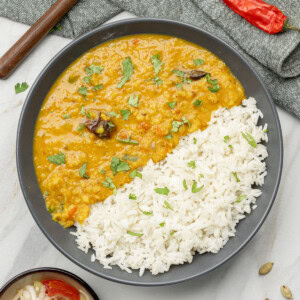
Masoor Dal (Red Lentils)
Video
Ingredients
- 1 cup Masoor Dal (Split Red Lentils)
- 1/2 teaspoon Ground Turmeric (Haldi powder)
- 1 teaspoon Salt
- 4 cups Water , or 3 cups for pressure cooker method
- 2 tablespoon Ghee or Oil, use plant-based oil for vegan
- 1 teaspoon Cumin seeds (Jeera)
- 1-2 Dried Red Chili Peppers, break into 2 pieces, optional
- 1/4 teaspoon Asafoetida (Hing), optional
- 3/4 cup Yellow onion, finely chopped
- 6 cloves Garlic , crushed using mortar & pestle
- 1 inch Ginger, crushed using mortar & pestle
- 1 Green Chili Pepper, sliced or dice for more heat
- 1 cup Tomato, chopped
- 1/2 teaspoon Coriander powder (Dhaniya powder)
- 1/2 teaspoon Red Chili powder (Mirchi powder), adjust to taste
- 1/4 teaspoon Garam Masala, optional
- 1 teaspoon Lemon juice, optional
- Cilantro leaves, chopped for garnish
Instructions
- Wash the dal: Add dal and regular tap water to a bowl and swirl with your hands. Then drain the water. Repeat 2-3 times until the water is clear.

Stovetop Method
- In a medium pot, add the dal with 1/2 teaspoon turmeric, 1 teaspoon salt, and 3 1/2 cups of water. Bring to a boil on medium-high heat.

- Now, reduce the heat to medium-low and let the dal simmer for about 30 minutes until it is soft and can be mashed easily.

- While the dal is cooking, you will see yellow/white scum on the top; this can be removed with a slotted spoon. Stir at regular intervals. Once the dal is cooked, remove from heat.

Pressure Cooker/ Instant Pot Method
- Transfer the rinsed dal to an instant pot or stovetop pressure cooker. Add 1/2 teaspoon turmeric, 1 teaspoon salt, and 3 cups of water. Give it a stir. Pressure cook for 2-3 whistles or for 5 minutes in the instant pot. Let the pressure release naturally.
Making tadka
- Heat ghee or oil in a large pan or dutc oven on medium heat. Add the cumin seeds and let them sizzle. Then add dried red chili peppers and hing. Saute for a few seconds.

- Add the diced onions and cook for 5-6 minutes until they are soft and light golden in color.

- Add the crushed ginger, garlic and green chili. Saute for another minute until the raw smell is gone.

- Add the chopped tomatoes, coriander powder, and red chili powder. Give it a stir. Cook for 5-6 minutes until the tomatoes soften. You can cover with a lid for 2-3 minutes which helps to soften the tomatoes quickly. You want to cook this onion tomato masala until oil oozes out from the sides.

- Add the boiled dal to the pan and mix. You can add 1/2-1 cup of water to adjust the consistency of the dal as you prefer.

- Let the dal simmer for 3-4 minutes on medium-low heat. Add the garam masala and sprinkle the lemon juice. Garnish with chopped cilantro.

- The masoor dal is ready to be served. Serve with some warm rice or roti for a comforting meal.




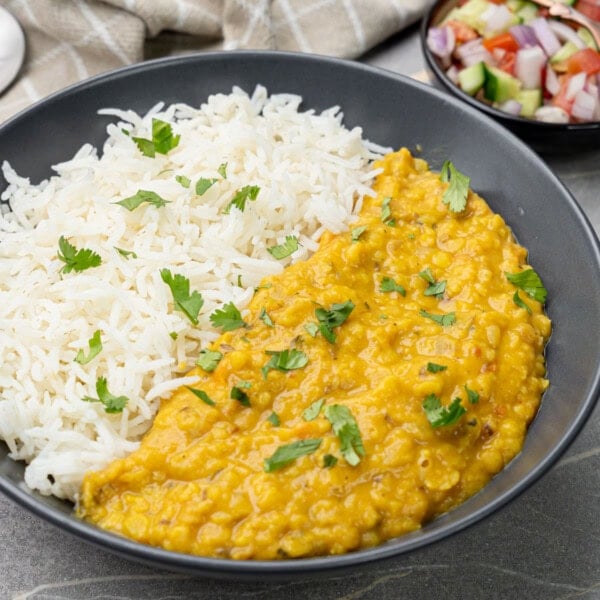
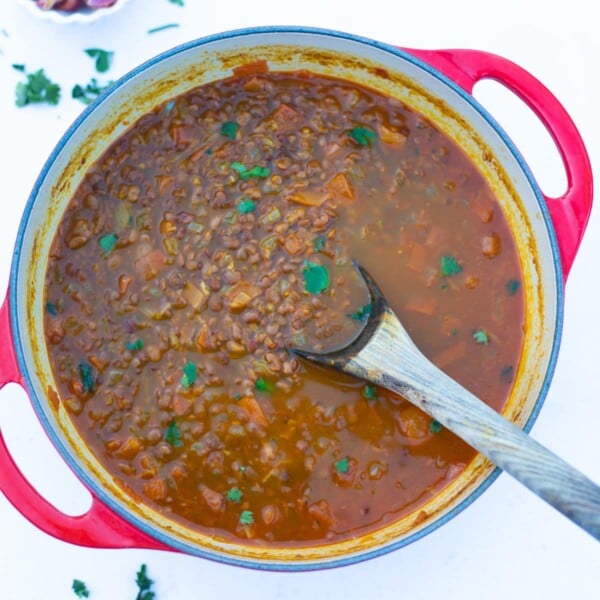
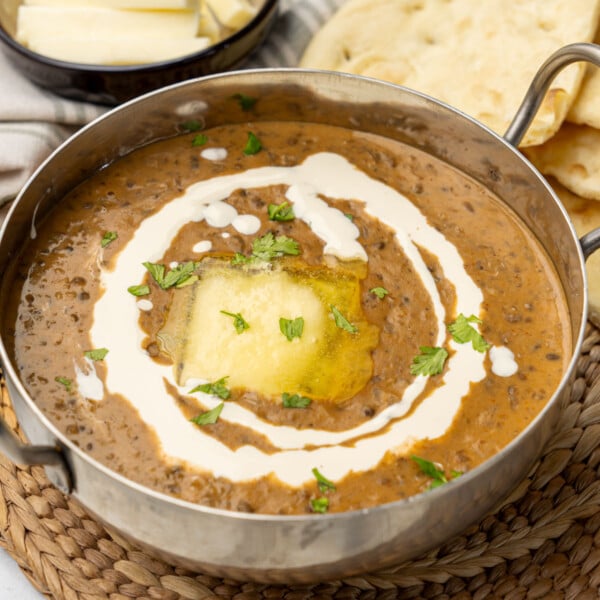


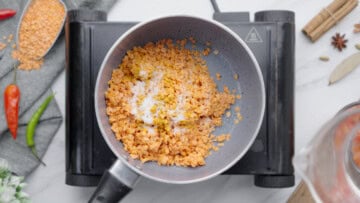

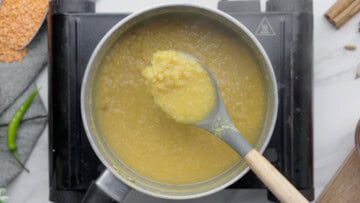
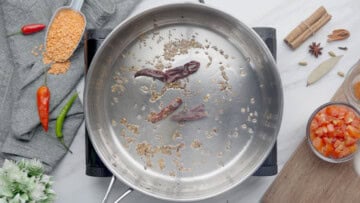
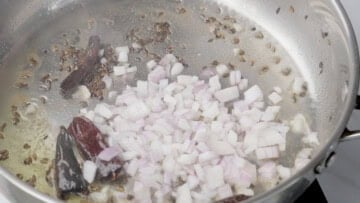
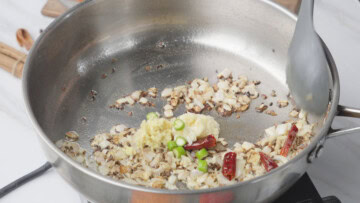
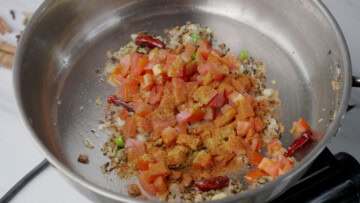

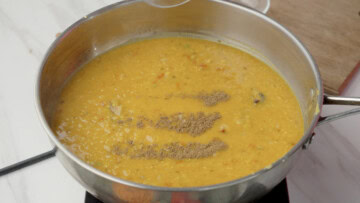
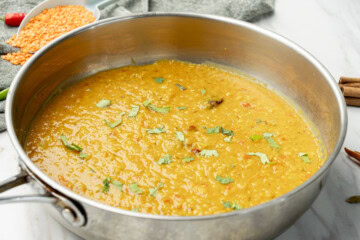
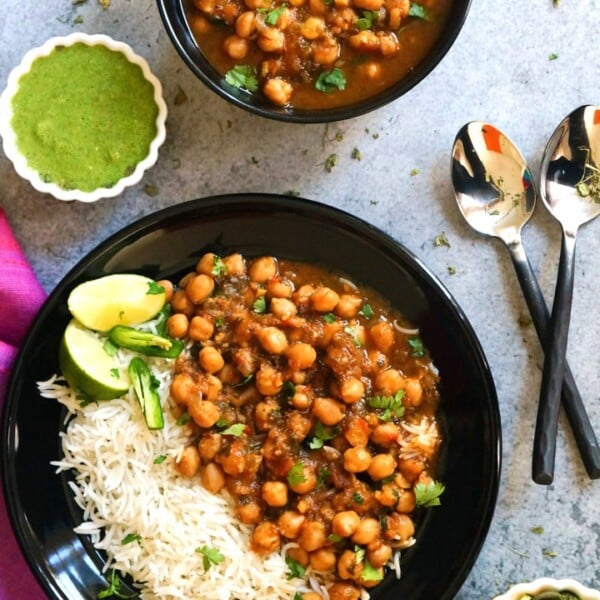
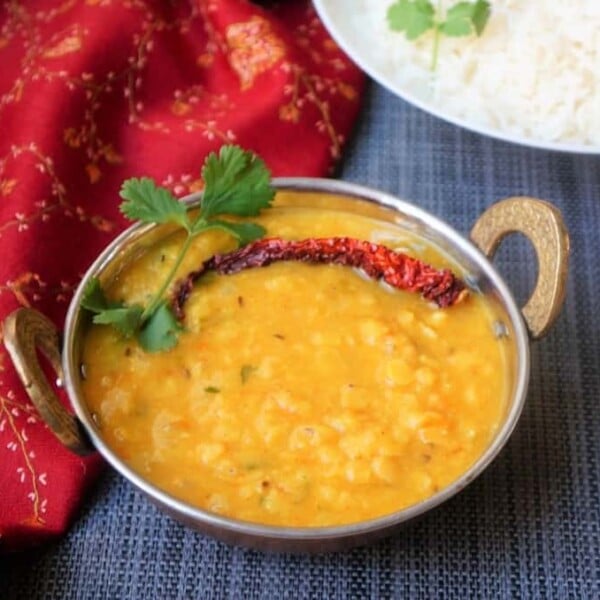
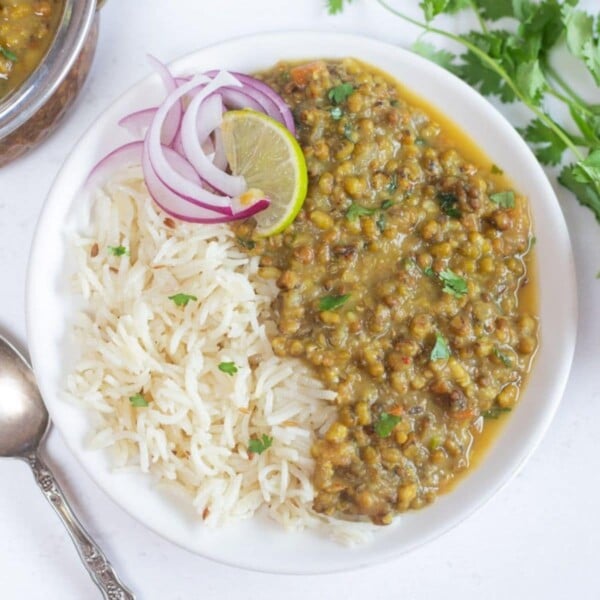
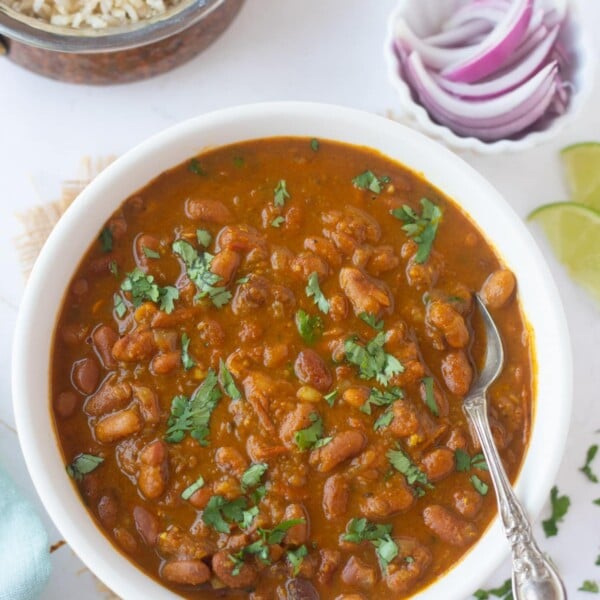








All I can say is WOW!! I have already made this recipe 4 times in less than 10 days. Everyone who has tried it has absolutely loved it. Thank you Meeta. I have physically gone to two of my daughters homes and showed them how quick, easy and tasty the Masood day is. They are all hooked now.
Hi – Wow, thank you so much for this heartwarming message! 💛 Thank you for trying it, loving it, and spreading the love! 🙏😊